I’ve very recently switched from focusing on dressage to going over fences in the hunter/jumper (H/J) style. I’ll write another post about why (short answer, it’s fun!) This blog, though, is about all of the things that I didn’t know that it was assumed that I did.
I’ve been around horses most of my life. I’ve taken scores of lessons, competed in dressage and eventing, and as a young child did a few horse shows and hunter paces. I’ve even gone fox hunting. I trail ride. I look competent in the saddle. I can stay on and balanced, whatever I’m asked to do. That’s good but it’s also problematic. Sometimes I look like I know what I’m doing, when I actually don’t have a clue. My trainer, Steph, has been steeped in the H/J world her entire life. There are some things that she assumes that I know to do. Like closing my leg on the saddle when I go over a jump.
A dressage rider’s aim is to have an open angle in the hips, and to drape their legs around the horse. No tension. No holding on. When Steph started giving me jumping lessons, it was as an off-shoot of the ground pole work that we were doing. We were doing cavaletti to improve Tonka’s dressage. I thought it’d be fun to go over a cross-rail. Tonka seemed game. Steph said okay. The first couple of lessons were in my dressage saddle. Although I’d shortened my stirrups, my legs were still draped around the horse, and so when going over the jump I was far more “in the air” than I should have been. The only thing keeping me on Tonka’s back were the stirrups and balance.
As Tonka got more and more enthusiastic about the jumping, I was jumping more and more “out of the tack.” A switch to a jumping saddle improved things, but it wasn’t until Steph and I discussed my position that we realized that I had missed a key lesson – when jumping one closes the angles so that the thighs and lower leg are connected to the horse. Aha!
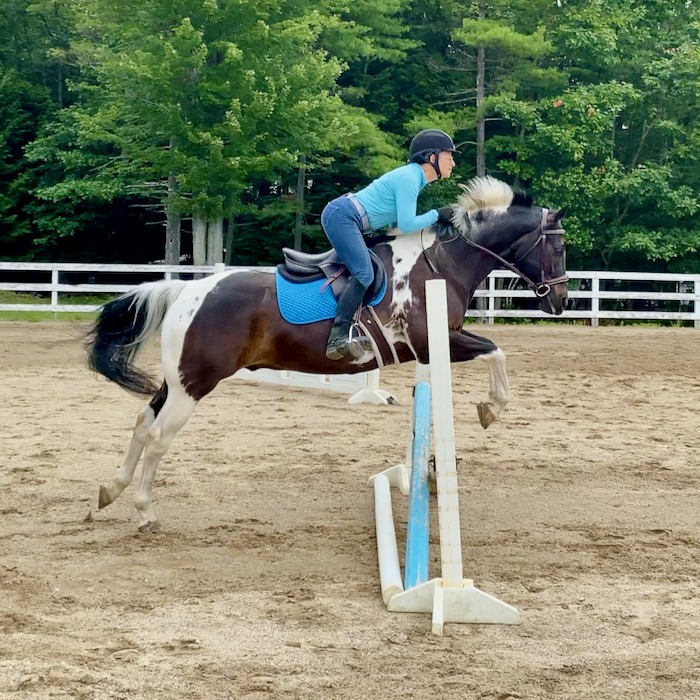
Here’s another position difference that isn’t obvious. All riders are taught to ride with their heels down. BUT. In dressage the balance point is over the soles of the feet.
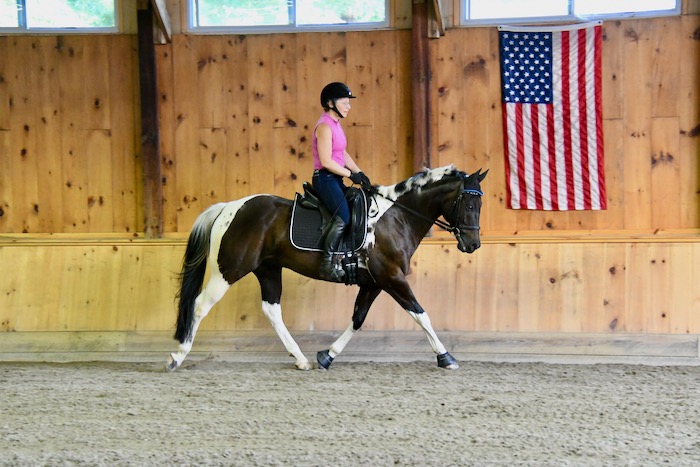
In a jump saddle my stirrups were shortened, but I kept that weight in the ball of my foot. As I’d been taught to do. When I watched videos of me landing on the downside of the jump, I looked like a steeplechase jockey. Why was it happening?
Here Tonka uncorked one of his over-achieving leaps. Note the surprise on my face. My leg straightens and the foot flies forward. At least I didn’t grab his mouth with the reins.

This was obviously not the correct position. Why was it happening? This week I asked Steph a fundamental question. Where was the weight in my foot supposed to be? Perhaps not in the ball of my foot but in the heel? Steph said “of course.” Steph didn’t realize that one could ride with heels down without the weight there in the heels, so she hadn’t told me to do so. I didn’t realize that one could ride with heels down and have the weight of my body straight down into them. Here was a fundamental difference between the two sports that neither of us were aware of.
Now, over fences, I’m much more secure and with my horse. Weight in the heels. Legs pressed onto the saddle. Even when Tonka takes off a stride too early, as in the photo below, I’m with him. Steve (who is an engineer) and I had a discussion about mass and physics and why one does it a certain way for one discipline and not another. I’ll spare you. Suffice to say that there’s a solid reason why one puts one’s feet and one’s weight where one does!
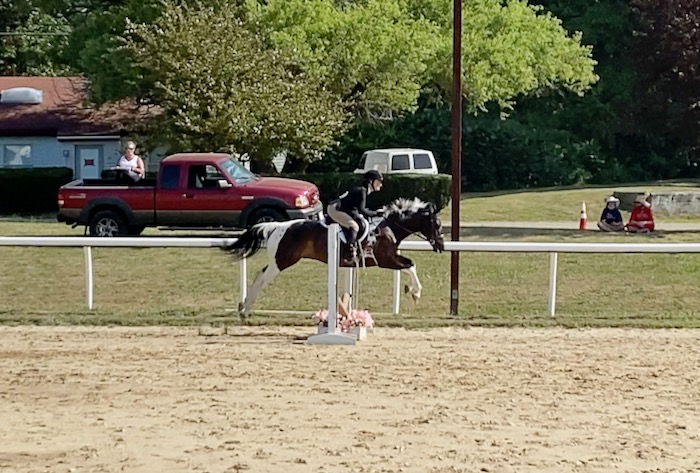
There are other things that I’ve been learning that my new H/J friends assume everyone knows. There is show etiquette. In the dressage warmup you make use of the entire ring. At any point one person might be leg yielding across the ring and another doing a 10 meter circle. At a H/J show you stay on the rail unless you are in the middle going over a fence. You do not do big figure 8s (sorry everyone!)
At a dressage show, you warm up and go straight into the arena. Depending on the level, you enter at a trot or canter.
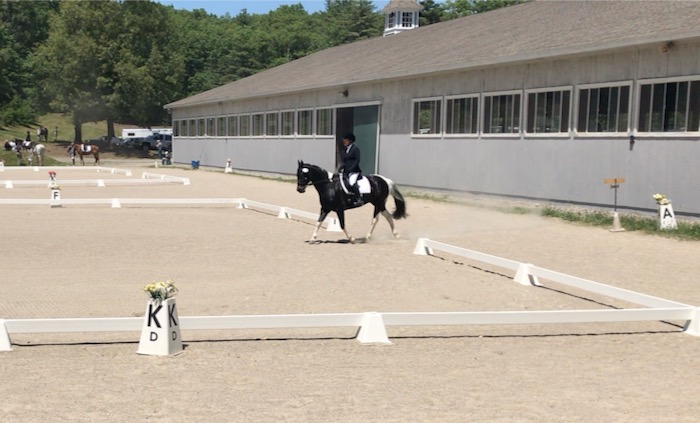
Yesterday at a show, at the in-gate, Steph told me to start at a trot. I assumed there, as I entered the ring! What I didn’t know was that if you enter or exit the H/J ring at a trot (never mind a canter!) you will be excused from the competition. Luckily, I wasn’t kicked out of the venue. This was a relaxed schooling show. Which is a good place to learn about rules that you don’t know enough to ask about in the first place.This rule made total sense. It’s a matter of safety. There are riders milling around the in-gate. Sometimes little riders. Certainly horses that you don’t want to startle or barge into.
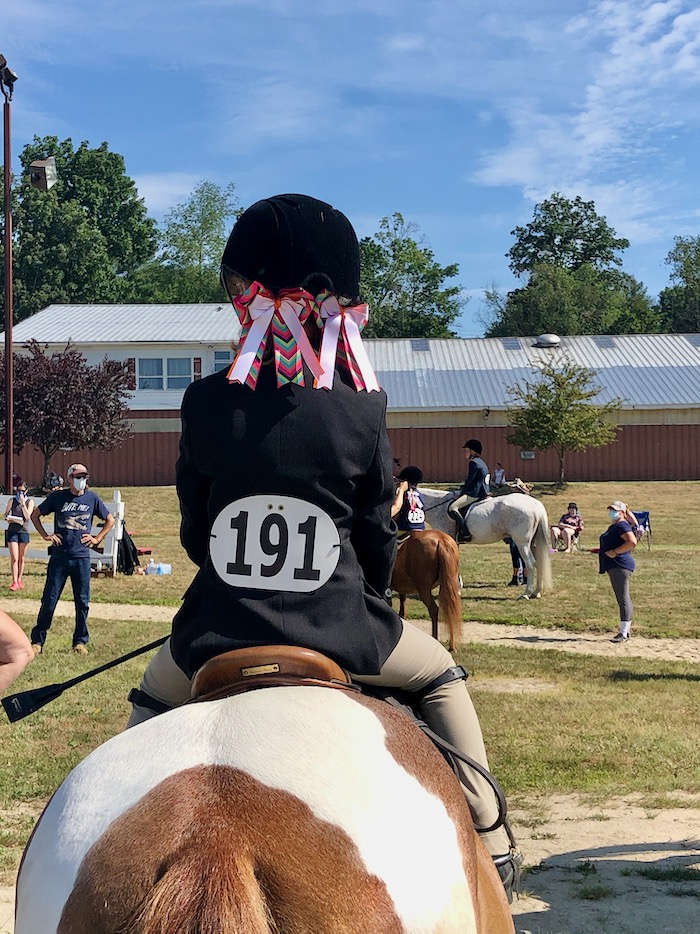
I’m sure that there are plenty of other bits of standard procedures and riding knowledge that my friends and trainer don’t even think to tell me because it seems intuitive to them. Fortunately, so far discovering these gaps has been more interesting than catastrophic.
Have you switched disciplines in a riding sport? What was different? What was it that you didn’t know that you didn’t know you didn’t know? Tell me in the comments!
PS We knew enough to come in first in a long stirrup hunter over fences (18-inch) class and have decent rounds in two others.



I don’t know that you’d say I had switched disciplines, but I certainly spent the first two years with a western and basic dressage emphasis, with a tiny exposure to jumping, and then the last year mainly with a jumper barn. Posting trot was maybe the biggest surprise? Posting to a fairly straight leg had been encouraged previously, and then for the last year posting as little as possible and developing more feel with my seat has been a big change in focus. I think some approaches to sitting trot also don’t really focus so much on heels down, whereas at my current barn, even for no-stirrup work we are asked to keep the toes up.
Interesting. “Toes up” and “heels down” are not exactly the same.